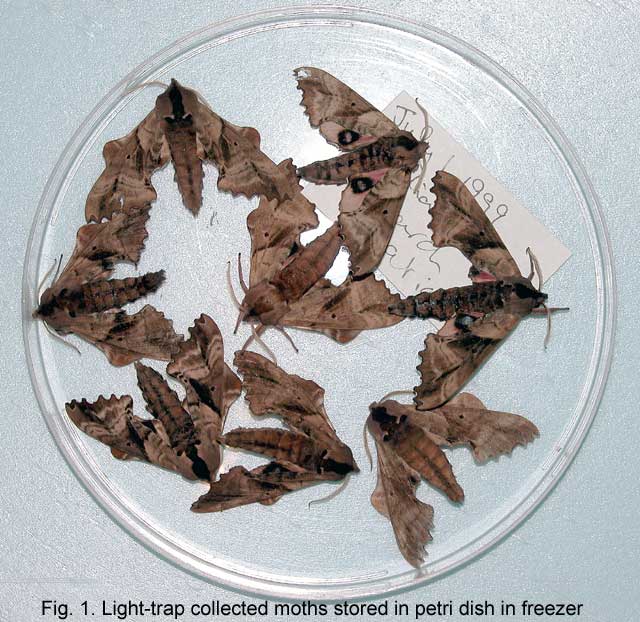
Tony Thomas, mothman@nbnet.nb.ca
He also writes,
"Hi Bill:
"When I wrote the degreasing article in Jan 2004 I was unaware of a similar article by Scott Smith written in 2001. My article almost looks like plagiarism so I am wondering if you could preface my article with the comment that it was written in January 2004 without knowledge of Scott's article."
I (Bill Oehlke) have taken this essay from Bruce Walsh's site with permission from Dr. Walsh and Tony Thomas.
As I am currently in the process of spreading some moths I thought the techniques I use may be of some usefulness to other moth collectors.
Field-pinning, storing
My first choice after a night of moth-collecting is to pin and spread the moths immediately, or store them in a freezer for a few days before spreading (Fig.1).

When immediate spreading proves impractical, my second choice is to field-pin the moths. Field pinning is simply pinning a moth but not spreading the wings (Fig. 2).
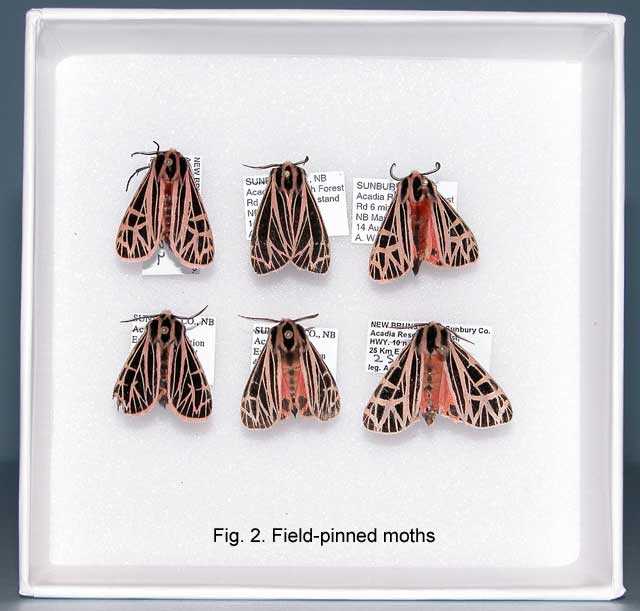
Such pinned moths are placed in the collection with spread moths of the same species then relaxed and spread when time permits. I find it easier to keep track of specimens that are pinned; never seem to know what material I have in my freezer; and even when I have a vague idea of what I have I never know how to locate it without taking everything out of the freezer. A recent innovation is to field-pin the moths using fine stainless pins (# 0, #1). This allows me to push the pin through the thorax without any consideration of getting it completely straight. When ready for spreading, the stainless pin is easily removed (after relaxing) and a more robust black pin can be inserted in the correct position. My third choice is to leave the specimens in a dish in the freezer (Fig. 1). I don't like to use envelopes for storing moths.
Degreasing
I degrease moths using Acetone. In Canada, Acetone can be purchased in hardware stores that deal with automotive products. It is used in certain aspects of car-body repairs. I use polyethylene food containers that have tight-fitting lids. I bore a hole in the top of the container and force the cork from a wine bottle into the hole. Greasy, field-pinned moths are pinned into the cork (Fig. 3).
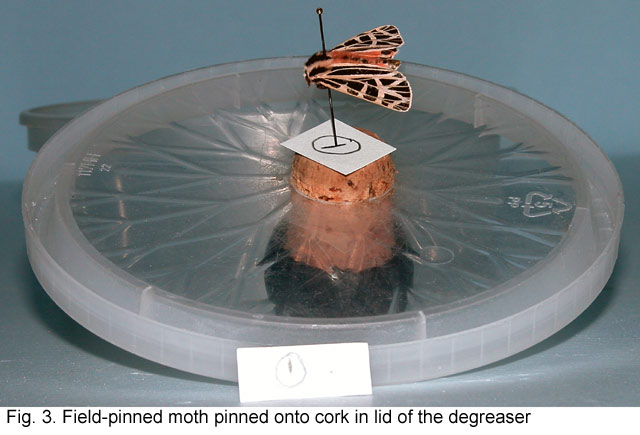
Sufficient acetone is placed in the degreasing dish to cover the moth when the lid is in place (Fig. 4). Spread moths that turn greasy are treated in the same way.
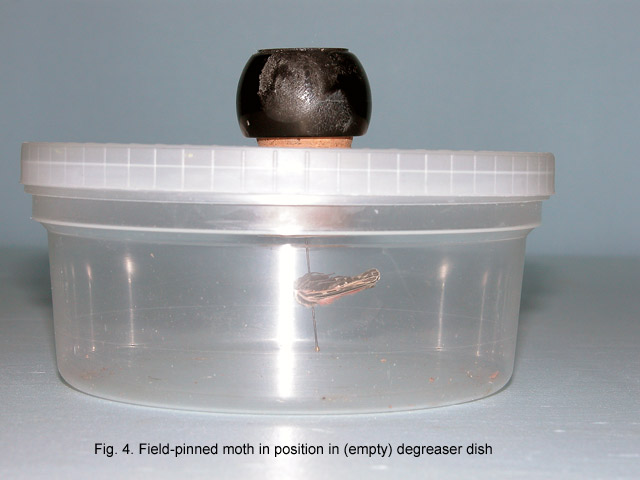
Different size containers are used for different sized moths. As acetone may affect some of the inks used for the locality label, I replace the label with a simple numbered (pencil) label and write the same number on the back of the locality label (Fig. 3).
Acetone is a colourless liquid and I usually use it in a series of 3 baths When starting for the very first time the acetone will be completely colourless (Fig. 5. last vial).
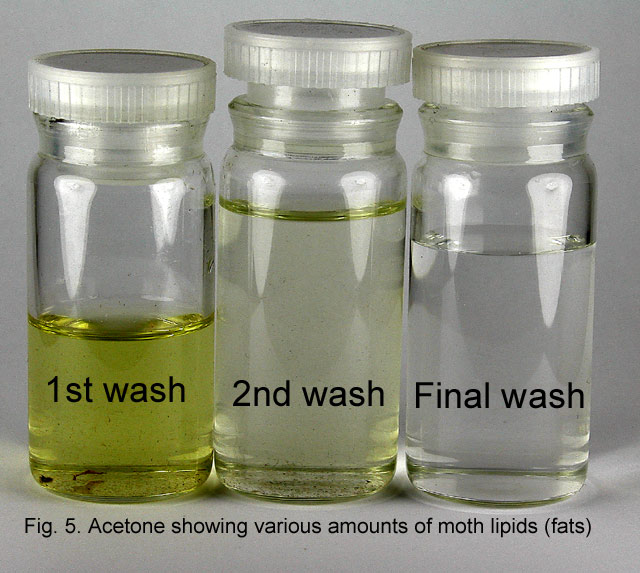
After 1 or 2 days in new acetone, the fats will dissolve out of the specimen and the acetone will turn yellow (Fig. 5, 1st wash). This 1st-wash acetone is removed and stored in a scew-cap glass bottle for later use. The dish is then one-half filled with clean acetone and the lid with the pinned moth placed in position. After 2 days the acetone removes any remaining fats. This acetone is saved and labeled 2nd wash (Fig 5). Place the moth in a final wash of clean acetone. The 1st wash acetone can be re-used several times until it becomes saturated with fat, it turns a darker yellow with each specimen. The specimen is then placed in the 2nd wash acetone that can also be re-used until it changes to a dark yellow. Eventually, the 1st wash is discarded, the 2nd-wash becomes the 1st-wash, the final wash becomes the 2nd wash and a new clean final wash is established.
Degreasing using acetone appears to work best at room temperature (20 C) or higher. During the summer I do my degreasing in a well-ventilated garage; in the winter (-25 C this week in New Brunswick) I move the system indoors but in a box that is vented to the outside. Acetone is volatile and flammable so care must be taken when using it.
Relaxing
Once again I prefer to work with field-pinned insects. I use a large air-tight polyethylene food container with a 1/2 inch layer of saturated horticultural sphagnum peat. This peat has natural fungicides that slow the formation of mould. I use a small amount of thymol to further prevent mould forming. The container (Fig. 6) was set up 30 years ago and has not yet developed fungus even though it has been kept wet the entire time. Specimens are simply pinned into a piece of foam and kept at 25 C for 2 days before spreading. The relaxing chamber is kept at an angle so that the water that condenses on the lid runs down to the edge and does not drip onto the specimens.

After degreasing and subsequent drying, I "fluff-up" the scales on the wings and body using a #0 artist's water-colour brush and blasts of compressed air. For the latter, I use a 10mL hypodermic syringe. This gives a very concentrated jet, the intensity of which can be varied by the amount of pressure on the plunger. I do this "fluffing-up" under a magnifying lamp. See figure below.

Use your browser "BACK" button to return to the previous page.
Goto Main Index